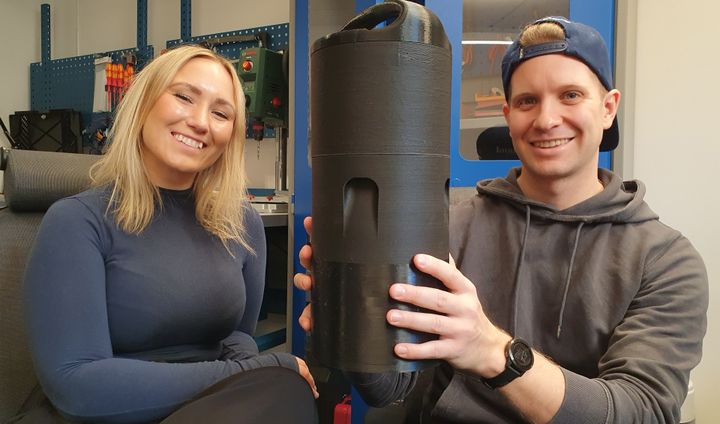Exterminating bed bugs would no longer require a ‘human sacrifice’
One reason getting rid of bed bugs is such an ordeal is that these pests have to be lured out of their hiding places by using people as bait. Two students at KTH Royal Institute of Technology are out to stop bed bugs in their tracks with a new device that would take the pain out of the process.

In the category of household pests, few are as difficult to exterminate as bed bugs.
Pesticide treatments depend on someone sleeping in the infested room as living bait to lure the creatures out of their hiding places for an evening’s blood feast—a big sacrifice for most people. The process can take weeks and presents a conundrum for hotels and guest houses.
But master’s students Maja Åstrand and Simon Lilja have designed a machine that relieves people of that unpleasant duty.
“You don’t have to be bait any longer,” Åstand says.
Bed bugs are attracted to CO2, which humans aspirate while sleeping. The students’ prototype device lures them out by emitting a far-reaching CO2 signal. Åstrand and Lilja are also developing an on-board camera system that would observe the bed bugs’ behavior and enable the machine to optimize its signal accordingly.
With a patent pending the two have formed a company, SimulAir, and named their product Ifigenia, after a princess from Greek mythology who is sacrificed to the goddess Artemis during the Trojan War.
While electronic bed bug monitors abound, they are meant to detect the presence of bed bugs. “Our technology focuses on what you do after you find a bed bug infestation,” she says. “We’re focused on the treatment of the infestation, and as far as we know there are no other technologies meant to attract and capture bed bugs as a means of treatment.”
Åstrand says the idea for the product came from a bed bug infestation she experienced four years ago in her own apartment. “That was really traumatic for me. I had to sleep as bait for eight weeks, and that’s the problem we have tried to solve by replicating this tactic.”
Next steps are to bring the prototype for tests in the UK where a lab is set up to simulate a furnished living space that’s infested with actual bed bugs, she says.
Lilja says they are optimistic that the machine’s allure is potent enough to prevent bed bugs from venturing into adjoining rooms during treatment. “Our ultimate goal is to enhance the machine's allure to a level where it even surpasses human attraction,” he says.
The technology may even shorten treatment times, he says. “This is one of the main things we are trying to evaluate during our field tests.
“Based on the science regarding both bed bugs feeding behavior as well as secondary population waves caused by nymphs and eggs we hope to be able to cut down the treatment time significantly.”
Subscribe to releases from KTH Royal Institute of Technology
Subscribe to all the latest releases from KTH Royal Institute of Technology by registering your e-mail address below. You can unsubscribe at any time.
Latest releases from KTH Royal Institute of Technology
New Swedish Initiative to Integrate Research and Healthcare4.4.2025 11:37:56 CEST | Press Release
A groundbreaking national initiative, Precision Omics Initiative Sweden (PROMISE), aims to connect research with healthcare and establish Sweden as a world leader in data-driven precision medicine.
For graphene production, a potential green alternative to mining graphite3.3.2025 14:14:40 CET | Press Release
Researchers in Sweden report a green alternative to reduce reliance on mining graphite, the raw source behind the "wonder material" graphene.
AI on aircraft can help prevent stalls and terrifying drops in altitude17.2.2025 15:58:14 CET | Press Release
Artificial intelligence could help prevent terrifying mid-air drops in altitude. In a new study, an international research team successfully tested a machine learning system for preventing trouble with turbulence.
Alternative to studded winter tires reduces airborne particles by 20 percent6.2.2025 14:41:07 CET | Press Release
On icy roads, studded winter tires can save lives – but they pulverize pavement and fill the air with dangerous, inhalable particles. A new Swedish study shows that both road wear and airborne particles could be reduced by as much as 20 percent if studs were made instead with an alternative hard metal.
As Scandinavian peninsula rises from sea, new satellite data shows gravity changes6.2.2025 09:15:25 CET | Press Release
Bouncing back from under the weight of Ice Age glaciers which have long since vanished, the Nordic region land mass is slowly rising above sea level. Two scientists at Sweden’s KTH Royal Institute of Technology have a refined a method for measuring and predicting the small details of how this slow movement changes Earth’s gravitational pull over time. One thing they found is that the Fennoscandinavian peninsula's land mass is more dense than previously known.
In our pressroom you can read all our latest releases, find our press contacts, images, documents and other relevant information about us.
Visit our pressroom